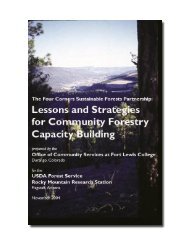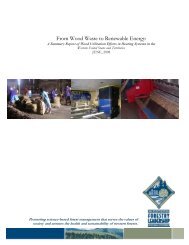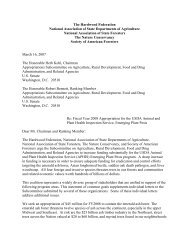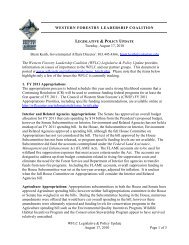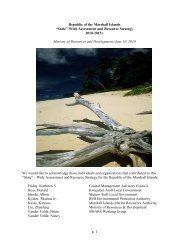Emission Controls for Small Wood-Fired Boilers - Western Forestry ...
Emission Controls for Small Wood-Fired Boilers - Western Forestry ...
Emission Controls for Small Wood-Fired Boilers - Western Forestry ...
Create successful ePaper yourself
Turn your PDF publications into a flip-book with our unique Google optimized e-Paper software.
control particulate emissions from biomass systems. The control efficiency of PM10 and PM2.5 appears<br />
to be 99% or greater, making this control technology very compelling. 1 There are no demonstrated<br />
applications of ESPs on small wood boilers in the United States. The pervasiveness of ESPs in Europe is<br />
due to stricter emission limits and higher subsidies. 2 There is one demonstrated ESP on a small coal fired<br />
boiler in North Carolina. At least two ESPs are slated <strong>for</strong> construction <strong>for</strong> small wood fired boilers in New<br />
England this year.<br />
Until recently, it has been commonly held that ESPs have significantly higher capital costs than<br />
baghouses. Given changes in ESP design and recent cost analyses, it is now thought that ESPs have<br />
comparable capital costs to baghouses <strong>for</strong> certain boiler sizes as they require less ancillary equipment<br />
(such as insulated ductwork, multicyclone <strong>for</strong> exhaust pre‐cleaning) than baghouses. This finding coupled<br />
with significantly lower operating costs and smaller spatial requirements than baghouses, have helped<br />
ESPs become especially attractive when advanced emission control is necessary.<br />
Significant pressure drops do not occur in ESPs; there<strong>for</strong>e, they do not require the extra energy to run<br />
fans to overcome the pressure drop. This means ESPs potentially will have a lower energy demand than<br />
all other add‐on controls.<br />
5.3 Baghouses (Fabric Filters)<br />
Baghouses utilize fabric filtration to remove particles from an exhaust gas stream. They are thought to<br />
provide the highest degree of control of all add‐on controls (99%+ of filterable PM2.5 emissions). 3 This is<br />
higher than the control efficiency measured in Greenfield, NH or 74%. Again, this lower value was likely<br />
due to tramp air flowing through a bypass during the stack test there.<br />
Cyclone/multicyclones are used to pre‐clean exhaust gas upstream of baghouses to reduce fire hazard. As<br />
with mechanical collectors, there is pressure drop across this control device caused by the exhaust gas<br />
passing through fabric. There<strong>for</strong>e, energy is required to draw exhaust through the fabric.<br />
The 2001 RSG report determined baghouses were technically infeasible due to threat of fire. A 2006 RSG<br />
BACT study also found them technically infeasible due to fire hazard and due to potential <strong>for</strong> filter bag<br />
clogging, a condition which occurs when the exhaust gas cools to the dew point causing moisture to<br />
condense on the particulate “cake” on the side of the bag walls. The end product is impermeable and can<br />
cause bags to rupture.<br />
It should be noted that filter clogging has the potential to occur in systems burning a wet fuel<br />
(approximately 25% to 50% moisture content) with variable firing rates. Filter clogging is not likely to<br />
occur in systems burning a dry fuel (approximately 15% or less moisture content) and operating<br />
consistently at a high firing rate, which prevents the exhaust from cooling and reaching its dew point.<br />
Historically in New England, baghouses have not been selected <strong>for</strong> systems with design inputs less than<br />
10 MMBtu/hour because the facilities which they would serve determined they did not have the financial<br />
or technical resources to purchase and service them. For example, this size boiler would serve a small<br />
school, which would typically not have a large and experienced facilities staff who could service the<br />
baghouse. In the absence of a significant subsidy, a small school would typically not have the financial<br />
resources to purchase a baghouse.<br />
There are now three demonstrated applications of baghouses on relatively small wood fired boilers in<br />
New England. These installations are not experiencing filter bag clogging problem because the vendors<br />
developed a design to avoid this problem. However, there was one fire which occurred in one of the<br />
systems which required the bags to be replaced. A multicyclone was installed after the fire. No fires have<br />
been reported since that time. These systems are described below:<br />
1<br />
Compilation of <strong>Emission</strong> Factors, AP 42, Chapter 1.6. US EPA, revised September, 2003<br />
2<br />
Personal communication with Biomass Energy Resource Center. September, 2009.<br />
3<br />
Compilation of <strong>Emission</strong> Factors. AP 42 Chapter 1.6. Revised September, 2003<br />
Resource Systems Group, Inc.<br />
<strong>Emission</strong> Control Technologies <strong>for</strong> <strong>Small</strong> <strong>Wood</strong>‐<strong>Fired</strong> <strong>Boilers</strong><br />
6 May 2010 Page 18



